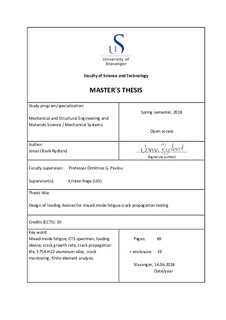| dc.contributor.advisor | Pavlou, Dimitrios | |
| dc.contributor.advisor | Rege, Kristen | |
| dc.contributor.author | Rydland, Jonas Olsvik | |
| dc.date.accessioned | 2018-09-13T08:59:06Z | |
| dc.date.available | 2018-09-13T08:59:06Z | |
| dc.date.issued | 2018-06 | |
| dc.identifier.uri | http://hdl.handle.net/11250/2562426 | |
| dc.description | Master's thesis in Mechanical engineering | nb_NO |
| dc.description.abstract | Traditional fatigue crack propagation tests are performed in mode I, i.e. with a cyclic load applied perpendicularly to the initial crack. However, fatigue cracks in real components are often subjected to mixed-mode loading. It is therefore important to obtain experimental data also for mixed-mode fatigue crack propagation.
In this thesis, a loading device suitable for mixed-mode I and II fatigue crack propagation tests of a compact tension shear (CTS) specimen has been designed and constructed. Computations of fatigue crack propagation life and maximum applied load to a CTS specimen in order to follow linear elastic fracture mechanics was performed. Based on these loadings a finite element analysis was conducted using ANSYS Workbench 17 in order to establish the maximum von Mises Stress and displacement occurring in the loading device during fatigue testing. The obtained results were then used to choose a suitable material for the loading device based on information gained from available S-N curves and relevant standards.
Suitable test specimens were prepared, and the produced loading device was used for experimental investigation of three CTS specimens of the 5754 aluminum alloy furnished in the H22 temper. The fatigue crack propagation tests were performed using a servo-hydraulic MTS fatigue testing machine. Tests were conducted for both pure mode I loading and mixed- mode I and II loading for a loading angle of 60 degrees.
Further, fatigue crack growth rates and direction of crack growth was measured.
A photo camera was used in order to monitor the crack growth during the fatigue tests. Necessary preparations were done, namely finding a suitable tripod for camera mounting and trying different surface coatings in order for improved visibility of the crack. A total of three different coating methods was tried. Finally, a procedure for performing mixed-mode I and II fatigue propagation tests using the designed loading device was prepared.
Based on results from conducted fatigue tests, the designed loading device was found well suited for mixed-mode fatigue crack propagation testing. | nb_NO |
| dc.language.iso | eng | nb_NO |
| dc.publisher | University of Stavanger, Norway | nb_NO |
| dc.relation.ispartofseries | Masteroppgave/UIS-TN-IMBM/2018; | |
| dc.rights | Navngivelse 4.0 Internasjonal | * |
| dc.rights.uri | http://creativecommons.org/licenses/by/4.0/deed.no | * |
| dc.subject | maskinteknikk | nb_NO |
| dc.subject | maskinkonstruksjon | nb_NO |
| dc.subject | mixed-mode fatigue | nb_NO |
| dc.subject | crack growth rate | nb_NO |
| dc.subject | 5754-H22 aluminum alloy | nb_NO |
| dc.subject | finite element analysis | nb_NO |
| dc.title | Design of loading devices for mixed-mode fatigue crack propagation testing | nb_NO |
| dc.type | Master thesis | nb_NO |
| dc.subject.nsi | VDP::Teknologi: 500::Maskinfag: 570::Maskinkonstruksjon og materialteknologi: 571 | nb_NO |

